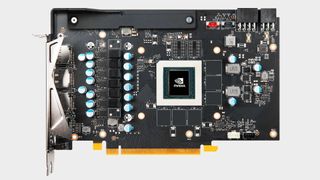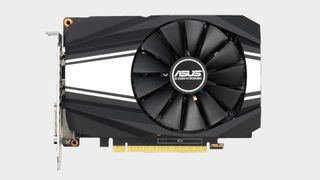Budget graphics cards from Nvidia, AMD, and Intel may finally materialise in 2022
It all comes down to price and availability, but it looks like some entry-level cards are on the way.

Will 2022 finally offer a graphics card for the budget gamer? It looks likely there might be a few on the way, as Nvidia, AMD, and Intel are all reportedly prepping what should be some of their cheapest GPUs for launch. The latest on that front is word of Nvidia's long-lost RTX 3050 and RTX 3050 Ti GPUs on desktop, which are reportedly arriving in the first half of 2022.
Nvidia first released the mobile RTX 3050 and RTX 3050 Ti way back in May, 2021, and these GPUs have made it into many a laptop since, including the MSI Pulse GL66 that our Alan reviewed and thought okay at best. You might think that tells us all we need to know about the discrete desktop cards. But apparently, you'd be wrong.
The RTX 3050 and RTX 3050 Ti are now rumoured to arrive with the GA106 GPU on desktop, says reliable leaker kopite7kimi. That's the same GPU as found powering the RTX 3060, and a step-up from the GA107 GPU commonly found powering the mobile RTX 3050 GPUs.
Update that: GA106-150-Kx-A1RTX 30508G GD6December 2, 2021
Importantly this shake-up would see the CUDA Core count of the RTX 3050 Ti increase from 2,560 on mobile to 3,072 on desktop—a 20% increase for the discrete card.
Similarly, these two desktop cards are said to come with 8GB of VRAM, as opposed to the rather paltry 4GB available on mobile. That's going to be big for performance, as in our recent review of the mobile RTX 3050 Ti we found its 4GB of GDDR6 memory to be one of the main factors holding it back from achieving decent frame rates.
The RTX 3050 Ti and RTX 3050 could be more the graphics cards we want them to be on desktop, then. Especially with DLSS thrown in, which was something I talked about wanting to see back in November 2020, when these cards were first rumoured. Ultimately, though, their success all boils down to price and availability.
The silicon shortage has ravaged graphics card supply, which has in turn caused ballooning price tags for top-tier PC gaming gear, such as the RTX 3080 or RX 6800 XT. That's a real shame because the underlying architectures powering both Nvidia and AMD's latest lineups are really powerful and excellently designed.
The biggest gaming news, reviews and hardware deals
Keep up to date with the most important stories and the best deals, as picked by the PC Gamer team.
The RTX 3060 12GB is a $329 graphics card. It's supposed to be, anyway. If you can find it in stock anywhere, you might find it selling for $100 more than that, at least. That's also the cheapest RTX 30-series card to-date. Without plenty of availability, the RTX 3050 Ti and RTX 3050 may face a similar fate, and that's going to be a really tough pill to swallow for PC gamers in need of an upgrade.
Though there's potentially a silver lining in all of this. Prebuilt gaming PCs will likely be prime candidates for these two cheaper Nvidia GeForce cards, and prices haven't nearly been quite so bad for these machines. So if these two cards can provide a cheaper way into PC gaming, without having to resort to an older generation GPU, I'm all for it.

It's not like Nvidia is the only option, either. Two weeks ago it was news of AMD's Radeon RX 6500 XT and RX 6400 that had us excited for some affordable options in PC gaming. No doubt these will also find their way into prebuilt PCs when they do arrive, and hopefully will be offered as discrete components, too.

Best wireless gaming mouse: ideal cable-free rodents
Best wireless gaming keyboard: no wires, no worries
Best wireless gaming headset: top untethered audio
Next year will also see the arrival of Intel in the discrete graphics card space, in earnest for gaming. The company will be releasing its Arc lineup of GPUs at some point in the new year, and the latest rumours from another reliable leaker, TUM_APISAK, tell tale of a budget GPU by the name of Intel Arc A380, which should feature 6GB of VRAM and offer around Nvidia GeForce GTX 1650 Super performance.
With all three manufacturers efforts combined, there's perhaps a chance that PC gaming can shake off the high price tags that have made it such a difficulty to get into this past year. PC gaming has become way harder to get into, and the loss of budget graphics cards is one cause for that, itself a symptom of larger global supply issues and demand. There used to be heaps of excellent budget cards, such as AMD's Polaris lineup, but sadly the global semiconductor shortage and surging demand, from gamers and non-gamers alike, has killed them off entirely.
Will the arrival of budget cards from Nvidia, AMD, and Intel make all of PC gaming's supply problems go away? No, but perhaps it can make PC gaming a little easier to get into for under $1,000.

Jacob earned his first byline writing for his own tech blog. From there, he graduated to professionally breaking things as hardware writer at PCGamesN, and would go on to run the team as hardware editor. He joined PC Gamer's top staff as senior hardware editor before becoming managing editor of the hardware team, and you'll now find him reporting on the latest developments in the technology and gaming industries and testing the newest PC components.
Most Popular






